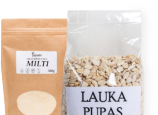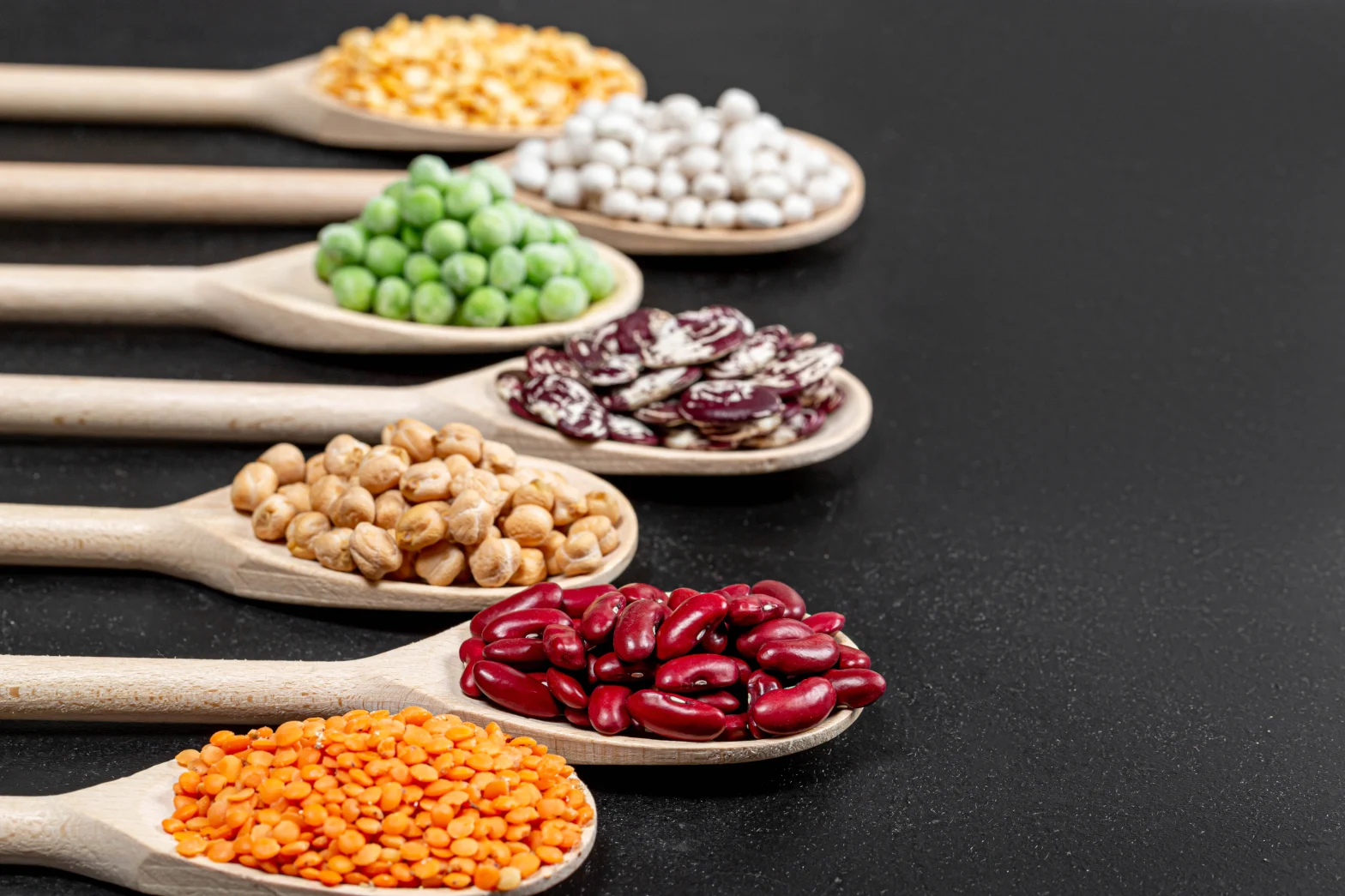Abstract
Today the demand for plant-based protein is growing rapidly due to increased awareness of animal protein growing costs and limited supply and has been highly related to biodiversity loss, climate change, and freshwater depletion. Legumes are in demand for their high content of protein, minerals, vitamins, and carbohydrates, also including dietary fibre. Legumes are rich in macronutrients and micronutrients but also contain anti-nutritional factors. One of the most important anti-nutritive properties of legumes is their high trypsin activity. The length of time required for the preparation of legumes has limited their frequency of use compared to recommended intake levels. By heat treatment, an anti-nutritional component in legumes can be mostly removed. The possibility of using extrusion cooking, microwave dryer, roasting equipment, etc., is widely studied. Roasting is one of the widespread methods for processing legumes that significantly enhances the texture, flavour, colour, and product appearance. The latest studies in the processing of legumes report valuable results after the combined processing, wet roasting, which includes: dehulling, soaking, and roasting. Heat treatment can be a potential way to improve legumes use in food production: reducing the time required for processing, preparation and improving nutritional value. Key words: legumes, protein, plant-based, roasting, heat treatment, anti-nutrients.
Introduction
Rapidly is raising the need for plant-based proteins with increasing perception of the carbon footmark indused by meat and dairy foods, as plant-based foods have smaller carbon footmarks. Legumes are in the spotlight among all plant-based protein sources and causes a significant role in human diet for their high composition of protein, minerals, starch, vitamins, and carbohydrates, including dietary fibre. Legumes are especially significant since the utilization of animal meat proteins is limited, because of restricted availability or ethical, nutrition, and religious habits (Pasqualone et al., 2020; Park et al., 2020; Lignicka, & Galoburda, 2022). Although many legumes are nutritious, it is difficult to cook them. It is due to rich amylose content, starch is forming up to 32% of the legumes composition (Gani et al., 2016). Among these starch molecules, there are hydrogen bonds that make the legumes, especially beans, very dense, and a high energy capacity is requisite to smash those hydrogen bonds structure by heating processes (Du et al., 2014). There are many treatment processes performed to carry off, that legumes for the human organism are eventually digestible, mainly fully free from anti-nutritional factors, like trypsin inhibitors, lipoxygenases, and glycoproteins, as lectin, vicin or convicin. Compounds in legumes like tannins, polyphenols, and phytic acid have been mentioned in terms of their affect on the human organism and should be considered too. Anti-nutrients are the binders that make a bond with the nutrient substances in the food and form those food compounds unaccessible for absorption in the human body (Samtiya et al., 2021). Anti-nutrients can be removed or decreased via numerous treatment processes of the legumes like soaking, germination, heating, and fermentation. Soaking is the most economical and easiest process, in addition, to considering the anti-nutritional factors inactivation. The dehulled process is used in terms of protein enrichment in peas and beans (Mohamed et al., 2011a; Jiang et al., 2016; Samtiya et al., 2021). To tackle these anti-nutritional issues mentioned before, there is a rising need to evolve an effective treatment methods for advanced legume utilization, thus the present study aimed to review research findings for treatment methods for legumes as well as innovative and structured technology resolutions for cost reduction including maximum removal of anti-nutritional compounds.
Materials and Methods
Monographic method was applied for this review. The review recapitulates results of advantages and disadvantages of legumes and their treatment and processing possibilities. Literature mainly from nutritional scope of different scientific journals was used in development of the study. The review includes material from research conducted in India, China, Australia, Greece, Egypt, Iran, Germany, etc
Results and Discussion
Advantages and disadvantages of legumes
Nutrition of legumes for human includes lentils, peas, millet, peanuts, lupines and varied botanical classifications different types of beans, also soy (Kinyanjui et. al., 2015; Park et al., 2020; Schmelter, Rohm, & Struck, 2021). Soybeans (Glycine max L.) are the first most obtained legumes in the world, next second place is taken by peanuts (Arachis hypogaea L.) providing an important source of human nutrition (Jiao et al., 2014). The legume protein content depends on botanical classification and is up to 200% higher compared to grain protein content (Simons & Hall, 2018). The legume fat content is small and is around 4 g per 100 g of dry matter, but not for soybeans (Glycine max L.) (Schmelter, Rohm, & Struck, 2021). Lupines (Lupinus L.) contains a higher fat content up to 15 g per 100 g and chickpeas (Cicer arietinum L.) contains up to 7 g per 100 g. Legumes have a quite low content of sulphur-containing amino acids, such as methionine and cysteine. Legumes area good source of dietary fibre, proteins, B group vitamins, starch and minerals. Starch is the main fraction in the dry matter of legumes, like all plant-based seeds and legume mineral content is from 3 up to 5 g per 100 g of dry matter (Rebello et al., 2014; Simons & Hall, 2018; Lignicka, & Galoburda, 2022). A nutritional disadvantage of legumes is their anti-nutrients, they are known as compounds that by itself or over their metabolic compounds arises in living organisms, obstruct food application and have an effect on the health of animals and humans (Mohamed et al., 2011a). Non-protein amino acids, protease inhibitors, lecithins, phenolic substances, flatulence produces, saponins, and non-starch polysaccharides are the most popular anti-physiological compounds in legumes (Mohamed et al., 2011a). Protease inhibitors are widespread compounds reducing digestibility by blocking one or another trypsin or chymotrypsin. Trypsin inhibitors inhibits the proteolytic activity of the digestive enzyme trypsin, thus decrease or hinder the protein digestibility (Gulewicz et al., 2014). Phytic acid decreases mineral absorption. The complex formed from phenolic products or their oxidized compounds connected with enzymes, essential amino acids, and other proteins, thereby decreasing protein digestibility and nutrition value (Grela et al., 2017). Human organism does not have the capability to hydrolyse phytate and has no capability to absorb it, thus phytate implicates into cause less bioavailable minerals. Phytate negatively acts on the bioavailability of positive ions such as Fe2+, Fe3+, Zn2+, Ca2+, and Mg2+ divalent and trivalent minerals by being negatively charged (Gemede, & Negussie, 2014; Samtiya et al., 2021). Phenolic compounds in legumes can span from simple compounds (phenolic acids) to highly polymerized products (tannins), that may impair protein bioavailability (Karkanis et al., 2018). Tannin could decrease iron absorption by setting up a bond with protein and creating a complex. Intake of high concentrations of tannin can cause side effects such as proteins, essential amino acids, and specific tissue elimination from the human body, and either induce gastrointestinal tract damage (Adeyemo, & Onilude, 2013). Flavonoids are announced as the most plentiful polyphenols in the human nutrition and legumes contain them too (Mohamed et al., 2011b). In the human colon high quantity of polyphenols may inhibit reproducing of significant colon microorganisms (Samtiya et al., 2021). Lingy an et al. (2017) emphasize that some polyphenols in high amounts can also have a genotoxic or carcinogenic trait. Dietary polyphenols can inhibit iron absorption and decrease folic acid and thiamine motion in human organism (Hua, & Tsao, 2016; Samtiya et al., 2021)
Additional disadvantage is also the unpleasant “beany flavour” of untreated faba bean (Vicia faba L.), thus the use of this bean has been commonly limited. Faba bean (Vicia faba L.) is high in proteins and due to the activity of endogenous enzymes can induce unpleasant “beany flavour”, thus their utilization in foods gives challenges regarding the quality of the sensory. Lipoxygenase is an enzyme which catalyses the oxidation of fatty acids (like linolenic and linoleic) into hydroperoxides. Peroxidases in the bean tissues catalyses varied oxidation-reduction reactions that have an impact on lipids. Peroxidase is generally applied to appoint conformity of heat processes, because this enzyme is usually the most heat-stable in plants. To resolve the faba beans (Vicia faba L.) “beany flavour” issue is suggested to use treatment with microwave heating, steaming, kilning, oven heating, and autoclaving (Jiang et al., 2016; Sun et al., 2020). Besides, not fully cooked kidney beans (Phaseolus vulgaris L.) can be toxic to human health, since the existence of the naturally occurring toxin phytohemagglutinin. The usage of slightly cooked kidney beans (Phaseolus vulgaris L.) in human food can guide to poisoning of food, implicate nausea, gastroenteritis, and diarrhoea. The inactivation of phytohemagglutinin is also disturbed because of the kidney bean’s dense texture (Phaseolus vulgaris L.) (Sun et al., 2020).
Another reason is that legumes require prolonged soaking and cooking processes, thus they are not valued by all consumers (Karkanis et al., 2018). Also, the usage of legumes in baked products is increased remarkably, due to the challenges of the growing amount of population who has coeliac disease (Simons & Hall, 2018). Legume flour is noticed as an alternative raw product for cooked food, due to its high amount of fibre and protein (Karkanis et al., 2018).
The reasons for the strengthened growth of legumes are mostly high agricultural sustainability aspects like the fact that they may be regarded as really nutritious and symbiotic fixation of atmospheric nitrogen (Schmelter, Rohm, & Struck, 2021). Thus, to get rid of disadvantages and highlight valuable in legumes is important to use the correct treatment methods.
Treatment and processing possibilities of legumes
Separation of unpleasant components in legumes is highly required to improve organoleptic acceptability and nutritional quality, and to help effectively cultivate their potential as food from plant for humans (Mohamed et al., 2011b). Various food treatment methods such as soaking, germination, cooking, dehulling, and fermentation are known to increase the nutritional value in legumes and also decrease anti-nutritional factors successfully (Mohamed et al., 2011a). The most effective processes to get rid of anti-nutritional compounds in legumes are germination and fermentation, but their usage remains limited due to the certain organoleptic properties they cause and the additional work-load they involve (Mohamed et al., 2011b). Various physical processes have been suggested to remove or decrease anti-nutritional compounds in legumes. The physical treatment processes involving soaking and heating strongly enrich legume nutritive quality, see used methods in Table 1.
Pre-treatment of legumes:
legumes are mainly soaked in water for a few hours before cooking, fermentation or germination methods are used for treatment (Kinyanjui et. al., 2015). Soaking is a convenient way to decrease anti-nutrients (Samtiya et al., 2021). Mohamed et al. (2011a) have explored that soaking beans could decrease the amount of trypsin inhibitor activity under the control point. Trypsin inhibitors activity was lower in kidney bean (Phaseolus vulgaris L.) around 18 %, by soaking (Ramakrishna et al., 2006). Khattab & Arntfield (2009) showed that peas (Pisum sativum L.) and kidney beans (Phaseolus vulgaris L.) notably decreased their trypsin inhibitor level by up to 10 – 19% by using a soaking treatment. Their investigation represented varieties in the level of trypsin inhibitor decrease by various experimented legumes soaking and the highest decrease of trypsin inhibitor was gained for kidney beans (Phaseolus vulgaris L.) (Mohamed et al., 2011a). The soaking process may be adaptive by bean canners, particularly used by bean breeds which easily gap in the canning process. Soaking in low pH and in CaCl2 solutions promote to enhance the firmness of the cooked beans and thereby prolong the heating time (Kinyanjui et al., 2015). The mechanism why heating time in beans is prolonged is very complex. Gained results from Kinyanjui et al., (2015) study indicate at either bean hulls or pectin is the reason for bean cooking time. Briefly, soaking beans for 24 h gives a decrease in total phenolic amount reaching up to 31 – 55%. The less effective in decreasing total phenolic compounds by soaking is in soybeans (Glycine max L.), compared to other tested beans like a kidney beans (Phaseolus vulgaris L.) and mung bean (Vigna radiate L.) (Mohamed et al., 2011b). Similar results in phenolic compound level changes were gained by Paramjyothi & Anjali (2005) for chickpeas (Cicer arietinum L.), Khandelwal et al. (2010) for Indian legumes, and Ramakrishna et al. (2006) for mung beans (Vigna radiate L.). Total phenolic compound reduction by the soaking process could simply be because phenolic compounds leach out in the soaking substance (Ramakrishna et al., 2006). Xu & Chang (2008) mentioned that the situation of difference in a decrease in total phenolic compounds during the soaking process may be because there is a contrast in the dispensation and amount of phenolic compounds in the beans hulls and cotyledon between the examined beans. Dehulling means the outer covering removal of the legumes. It could be carried out manually by the usage of pestle and mortar, but nowadays, milling equipment is implemented. The application of dehulling reduces the amount of anti-nutritional compounds, like phytic acid, tannins, and polyphenolic content (Samtiya et al., 2021).
Biotechnological methods:
Biotechnological methods like germination and fermentation are used also for legume treatment.
Germination is an effective stage of metabolism wherein anti-nutrients are decreased, this is the biotechnological process where proteases break down cellular proteins, but only an average effect with regard to the decrease in especial of the trypsin inhibitor. Germination may boost legume nutritional value by transforming the chemical structure and decreasing the anti-nutrient factors (Kumari, Krishnan, & Sachdev, 2015; Samtiya, Aluko, & Dhewa 2020).
Fermentation is also the biotechnological process where complex biomolecules are converted by microorganisms (specially selected yeast or bacteria strains) into simple molecules. Fermentation treatment improves antioxidant and nutritional quality of legumes. The fermentation effectiveness depends on the legume and the microorganism strain used on the lower level of anti-nutritional factors. Fermentation could eliminate few anti-nutritional factors, like phytic acid, and besides gives an affirmative result on bioavailability and protein digestion (Samtiya et al., 2021). Besides, genetic engineering methods are created to remove the genes which are responsible for metabolic pathways for decreasing the output or inactivation of the anti-nutrients (Awadhesh et al., 2019).
Cooking methods:
Different heating treatments, such as boiling, autoclaving, roasting hot air drying, and microwave cooking were used to reduce anti-nutrients significantly (Samtiya et al., 2021).
The roasting process application is more popular in nuts than in beans. Roasting forms desirable sensory properties and significantly improves the colour, flavour, texture, and appearance of nuts. Peanuts (Arachis hypogaea L.) after roasting have the potentiality to be used as a snack (Bagheri et al., 2019). The usage of the roasting method has more advantages, such as advanced product quality, high roasting capacity, prolonged shelf-life of product, and decrease environmental pollution. In general, the infrared roasting treatment is a successful alternative treatment for utilizing peanuts (Arachis hypogaea L.) as a snack and can be adapted also to roasting the beans (Bagheri et al., 2019). Overall, frying, electric furnace roasting, hot air roasting, and coal-fired furnace roasting are usually applied roasting treatments. All mentioned roasting treatment methods are time-consuming, have reduced production rates, and have high energy costs (Jiao et al., 2014).
Mostly all grain flours trade in markets are milled by roller-milling equipment, which could be applied to legumes too. Although ultra-centrifugal milling mills fine flours with equable particle size dispensation, it is usually applied in chemical structure analyses (Jiang et. al., 2016). Microwave heating method successfully and quickly inactivated peroxidase and lipoxygenase in faba bean (Vicia faba L.), which are related to unpleasant “beany flavour” (Jiang et. al., 2016). Microwave heating at 950 W power for 1.5 min is sufficient to deactivate undesirable enzymes related with “beany flavour” and advance the milling quality of the legumes. Microwave heating has few preferences: reach high rates of heating and lower processing time compared to oven-based heating methods (Chandrasekaran, Ramanathan, & Basak, 2013). Conventional oven heating for 30 min at 170 °C as well inactivated the lipoxygenase and peroxidase enzymes in legumes flour. All heating methods create starch protein aggregates from legumes flour and they all are insoluble in water (Jiang et al., 2016).
Hydrothermal methods like extrusion using no chemicals are able as well enhance the functional properties of legume flours (Patil et al., 2018). Extrusion cooking method is determined to decrease the amounts of several anti-nutrients in legumes like tannins, phytic acid, trypsin inhibitors, and lectins. Furthermore, extrusion cooking is capable to higher the digestibility of protein and starch too (Pasqualone et al, 2020). Extrusion is a short time and high temperature method in which food are heated by the high temperature and automatic under pressure shear combination. Its outcome with chemical reactions and molecular modification by which functional properties, phytochemical structure, and nutrients of the food are transformed (Patil et al., 2018). Accordingly, legumes extrusion is an applicable scheme to add value to underutilized legumes and shorten preparation time, thus also to boost the utilization of these sustainable legumes (Pasqualone et al, 2020).
The hot air-drying method for beans may be effective to gelatinize starch on their surface area, and also for moisture migration. The major reasons limiting the evolution of the hot air-drying method are the drying process is time-consuming and the consumption of high energy, although this method is easy to operate and as well low in manufacturing cost (Li et al., 2022). However, the microwave radiation in the microwave drying method heats either at the same time the surface and interior areas of the legumes and these properties relieve processes of starch gelatinization and free moisture removal by drying. Thus, the microwave drying method has the advantage of increasing drying productivity and decreasing energy consumption compared with the conventional drying process (Haghi & Amanifard, 2008). Li and others (2022) explored that in a relatively short time the dried beans (Vicia faba L.) are fully cooked. Briefly, the optimum treatment properties to process the dried beans (Vicia faba L.) are firstly beans should be soaked for 4 h and steamed for 15 min, further applied by hot air drying with 70 °C hot air at a microwave.
All these cooking methods also reduce phytate, tannin, trypsin inhibitor, and a protease inhibitor and eliminate tannins and phytates from legumes (Samtiya et al., 2021). Besides, the physico-chemical properties of starch transforms performing treatment processes and via reaction with macronutrients like lipids and proteins, and its gives a remarkable result on the texture of legume products (Lignicka, & Galoburda, 2022). To achieve greater results and obtain a set of several properties, either sensory quality and increase anti-nutrient removal, there is a need to apply legume treatment methods by combining
Conclusions
This study has shown the good traits of legumes using them as a source of protein. Legumes contain some anti-nutritional factors like tannins, polyphenols, phytate, and trypsin inhibitor, these may inhibit mineral absorption, induce toxicity, and cause some other diseases. Accordingly, to gain beneficial nutrients from legumes, several treatments should be applied, such as soaking, dehulling, roasting, extrusion, boiling, germination, hot air drying, and fermentation which have proven to be effective. These are suitable treatments for eliminating anti-nutritional from legumes. In addition to treatment processes, biotechnological methods are used on legumes to obtain legumes with low phytate levels. The most effective results could be gained by combining these methods and reaching out with pleasant organoleptic quality and inhibited anti-nutritional factors fully from legume-based products.








